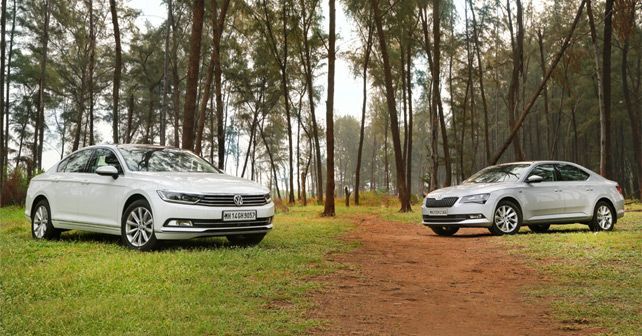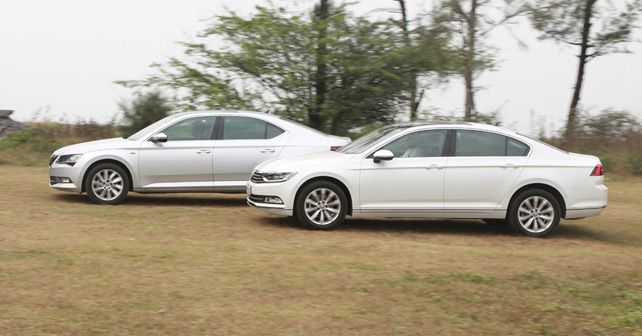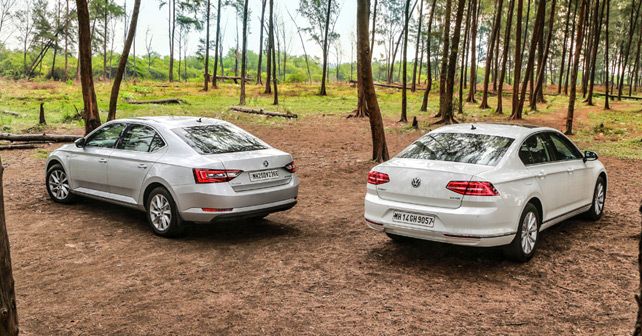Underneath the shell of both these cars lies the same DNA. So, which one is better?
Most younger brothers have to live up to the expectations set by their older brothers – making sibling rivalry a foregone conclusion. And this is exactly the situation that the Volkswagen Passat finds itself in. Its older sibling, the Skoda Superb, has been in the business for some time now and is possibly among the most well-rounded luxury saloons out there. It has enough space for a football field at the back, it’s well equipped and demands half the money when compared to other cars of its size. But, let’s not forget that the Passat and the Superb share the same DNA. Both cars are based on the Volkswagen’s MQB platform, and have the same engine and gearbox options. This is indeed a sibling rivalry at its best!
Shape of you
If both cars were to enter a beauty pageant, the Skoda Superb would easily come out on top. It has a more chiselled body with a sharp shoulder and a prominent character line. The headlamp cluster and taillights are striking, and its boot section has character too. I love what Skoda has done with their new design language – a perfect blend of style and elegance.
On the other hand, Volkswagen has taken a rather conservative approach in designing the Passat. And, considering that Indian buyers look for road presence, especially in this segment, the Passat flies under the radar a little too convincingly. Although, there’s nothing wrong with the subtle design cues of the Passat, when parked next to its sibling, the Volkswagen just doesn’t look as ‘superb.’ Two design elements that are worth pointing out, though, are its taillights and boot lid. While I love the taillights, the boot lid is a bit too plain for my liking.
From the Inside
Round two is where the battle gets a bit more interesting, as the equation is now reversed. The Passat’s interior looks a lot more sophisticated than the Superbs – thanks to the wood finish on the dash and door panels. Plus, the lines from the air-con vents continue across the length of the dashboard to give it an ultra-modern appeal. In comparison, although the Superb’s dash looks as neat as a new notebook, in terms of design it feels archaic. A lot of this has to do with the fact that it looks nearly identical to the Octavia. Having said that, its beige-and-black combination gives the cabin a sense of roominess – something that the all-black interior of the Passat struggles to achieve. In fact, the Superb has quite a bit more space on the inside – it’s a longer car and has a larger wheelbase after all.
The Skoda also gets a few brownie points for its boot space. It’s not only larger by a considerable 85-litre volume, but it also has a bigger hatch-like opening – making it more accessible. In the quality and fit-and-finish departments, though, the Passat is a clear winner.
Both cars come with all the features that are expected from cars of this class. However, there are a few differences that are noteworthy. The Superb’s front seats are heated as well as cooled, but the Passat gets just a heating function – which isn’t very useful in our conditions. The former has bi-xenon headlamps, while the latter comes with LEDs. The Volkswagen also comes with a 360-degree camera and an uber-cool Park Pilot, while the Skoda makes do with just a reversing camera and sensors.
Even it up
As far as the engine and gearbox go, both cars are exactly the same. They manage to extract 174bhp and 350Nm from an in-line-four turbo-diesel displacing 1,968cc. Both cars aren’t the quickest to take off, as they only come into their own once the torque kicks in post 1,700rpm. But, from there on, the mid-range is where the fun takes place. Keep the tacho needle vacillating up to about 4,200rpm and you’ll be able to keep them at their energetic best. Although we didn’t get a chance to test them for outright performance, the acceleration figures of both cars should be more or less identical – as they weigh about the same. The difference between the two is slightly more evident in terms of refinement, as the Passat feels relatively smoother and more fluid than its sibling. The German is somewhat quieter inside the cabin too. Both siblings have been fitted with smooth-shifting six-speed DSG transmissions. Shifting between gears is seamless in D as well as M – in the latter, upshifts are marginally slower than downshifts.
The right balance
The difference between the two cars really shows in the way they’ve been setup. Tuned for comfort, the soft suspension of the Superb is quite compliant on bad roads. Considering that a lot of buyers in this class are chauffer driven, this aspect will really be appreciated. Of course, on the flipside, the Superb doesn’t have the agility of its predecessor. It tends to roll while cornering, and any undulations mid-corner unsettle it even further. In fact, even when driving on highways, expansion joints and rough patches lead to unwarranted vertical movement. Around corners, the Passat feels a lot more composed and planted than its sibling. There’s a firmness in the suspension setup that restricts body movement and doesn’t upset the car’s composure. Despite this, the Passat manages rough roads fairly well – if not better than the Superb. Small bumps are managed with poise, but it’s the larger ones that you need to handle with care. The suspension tends to bottom out through large potholes.
Both cars come with four driving modes – Eco, Normal, Sport and Individual. In the Superb, toggling between these modes adjusts the power delivery, responsiveness of the gearbox and the feel of the steering. Aside from these adjustments, you can also alter the damping in the Passat – a first in class feature. The Passat’s steering is also slightly better weighted than the Superb.
Weapon of choice
While both these cars may have the same genes and share most of their mechanical parts, they do retain their individuality. If it’s comfort and space that you’re looking for, it can’t get any better than the Skoda Superb. Top that up with a plush ride and you have the makings of a splendid car to be driven around in. The Passat, on the other hand, feels better built on the inside and has a richer feel too. It also has a longer list of features for a premium of just about Rs.50,000. And then, of course, it feels a lot more planted around corners. Cabin space may not be excessive, but it’s plenty all the same. With all that the Superb can do, the benchmark for the Passat is obviously high. That said, the Volkswagen feels like the smarter younger sibling that doesn’t try to overachieve, but still manages to inch ahead without making a fuss about it.
- Skoda Superb
- Volkswagen Passat
Engine: 1,968cc / Inline-4 Cylinder / 16 Valve / Turbocharged
Fuel: Diesel
Transmission: 6-Speed DSG / Front-Wheel Drive
Power: 174bhp @ 3,600-4000rpm
Torque: 350Nm @ 1,500-3,500rpm
Price: Rs.32.40 lakh (Ex-showroom)
X-factor: If it’s comfort and space that you’re looking for, look no further than the Superb.
| Pros • Design, space & practicality | Cons • Interior design & handling |
Engine: 1,968cc / Inline-4 Cylinder / 16 Valve / Turbocharged
Fuel: Diesel
Transmission: 6-Speed DSG / Front-Wheel Drive
Power: 174bhp @ 3,600-4,000rpm
Torque:3 50Nm @ 1,500-3,500rpm
Price: Rs.32.99 lakh (Ex-showroom)
X-factor: The Passat can do almost everything that the Superb does, and it’s more fun from behind the wheel.
| Pros • Handling, interior design & quality | Cons • Overly conventional exterior design |

























Write your Comment